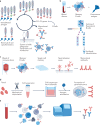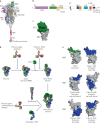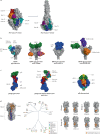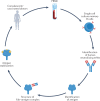Antibodies to combat viral infections: development strategies and progress
- PMID: 35725925
- PMCID: PMC9207876
- DOI: 10.1038/s41573-022-00495-3
Antibodies to combat viral infections: development strategies and progress
Abstract
Monoclonal antibodies (mAbs) are appealing as potential therapeutics and prophylactics for viral infections owing to characteristics such as their high specificity and their ability to enhance immune responses. Furthermore, antibody engineering can be used to strengthen effector function and prolong mAb half-life, and advances in structural biology have enabled the selection and optimization of potent neutralizing mAbs through identification of vulnerable regions in viral proteins, which can also be relevant for vaccine design. The COVID-19 pandemic has stimulated extensive efforts to develop neutralizing mAbs against severe acute respiratory syndrome coronavirus 2 (SARS-CoV-2), with several mAbs now having received authorization for emergency use, providing not just an important component of strategies to combat COVID-19 but also a boost to efforts to harness mAbs in therapeutic and preventive settings for other infectious diseases. Here, we describe advances in antibody discovery and engineering that have led to the development of mAbs for use against infections caused by viruses including SARS-CoV-2, respiratory syncytial virus (RSV), Ebola virus (EBOV), human cytomegalovirus (HCMV) and influenza. We also discuss the rationale for moving from empirical to structure-guided strategies in vaccine development, based on identifying optimal candidate antigens and vulnerable regions within them that can be targeted by antibodies to result in a strong protective immune response.
© 2022. Springer Nature Limited.
Conflict of interest statement
The authors declare no competing interests.
Figures





Similar articles
-
Neutralizing monoclonal antibodies for treatment of COVID-19.Nat Rev Immunol. 2021 Jun;21(6):382-393. doi: 10.1038/s41577-021-00542-x. Epub 2021 Apr 19. Nat Rev Immunol. 2021. PMID: 33875867 Free PMC article. Review.
-
Structural Basis of a Human Neutralizing Antibody Specific to the SARS-CoV-2 Spike Protein Receptor-Binding Domain.Microbiol Spectr. 2021 Oct 31;9(2):e0135221. doi: 10.1128/Spectrum.01352-21. Epub 2021 Oct 13. Microbiol Spectr. 2021. PMID: 34643438 Free PMC article.
-
Human Monoclonal Antibodies: On the Menu of Targeted Therapeutics Against COVID-19.Virol Sin. 2020 Dec;35(6):713-724. doi: 10.1007/s12250-020-00327-x. Epub 2021 Jan 4. Virol Sin. 2020. PMID: 33394351 Free PMC article. Review.
-
Structural Analysis of Neutralizing Epitopes of the SARS-CoV-2 Spike to Guide Therapy and Vaccine Design Strategies.Viruses. 2021 Jan 19;13(1):134. doi: 10.3390/v13010134. Viruses. 2021. PMID: 33477902 Free PMC article. Review.
-
Monoclonal antibodies for prophylaxis and treatment of respiratory viral infections.Curr Opin Infect Dis. 2022 Aug 1;35(4):280-287. doi: 10.1097/QCO.0000000000000846. Epub 2022 Jul 5. Curr Opin Infect Dis. 2022. PMID: 35849517 Review.
Cited by
-
Development of Therapeutic Monoclonal Antibodies for Emerging Arbovirus Infections.Viruses. 2023 Oct 30;15(11):2177. doi: 10.3390/v15112177. Viruses. 2023. PMID: 38005854 Free PMC article. Review.
-
[Precision medicine in infectious diseases].Inn Med (Heidelb). 2024 Mar;65(3):220-227. doi: 10.1007/s00108-023-01620-z. Epub 2023 Dec 1. Inn Med (Heidelb). 2024. PMID: 38038764 Review. German.
-
Therapeutic advances in COVID-19.Nat Rev Nephrol. 2023 Jan;19(1):38-52. doi: 10.1038/s41581-022-00642-4. Epub 2022 Oct 17. Nat Rev Nephrol. 2023. PMID: 36253508 Free PMC article. Review.
-
Structural basis for hepatitis E virus neutralization by potent human antibodies.Sci Adv. 2025 May 9;11(19):eadu8811. doi: 10.1126/sciadv.adu8811. Epub 2025 May 7. Sci Adv. 2025. PMID: 40333967 Free PMC article.
-
Small but Mighty: Nanobodies in the Fight Against Infectious Diseases.Biomolecules. 2025 Apr 23;15(5):610. doi: 10.3390/biom15050610. Biomolecules. 2025. PMID: 40427503 Free PMC article. Review.
References
-
- Behring EV, Kitasato S. Über das Zustandekommen der Diphtherie-Immunität und der Tetanus-Immunität bei Thieren. Dtsch Med. Wochenschrift. 1890;49:1113–1114. - PubMed
Publication types
MeSH terms
Substances
LinkOut - more resources
Full Text Sources
Other Literature Sources
Medical
Miscellaneous

